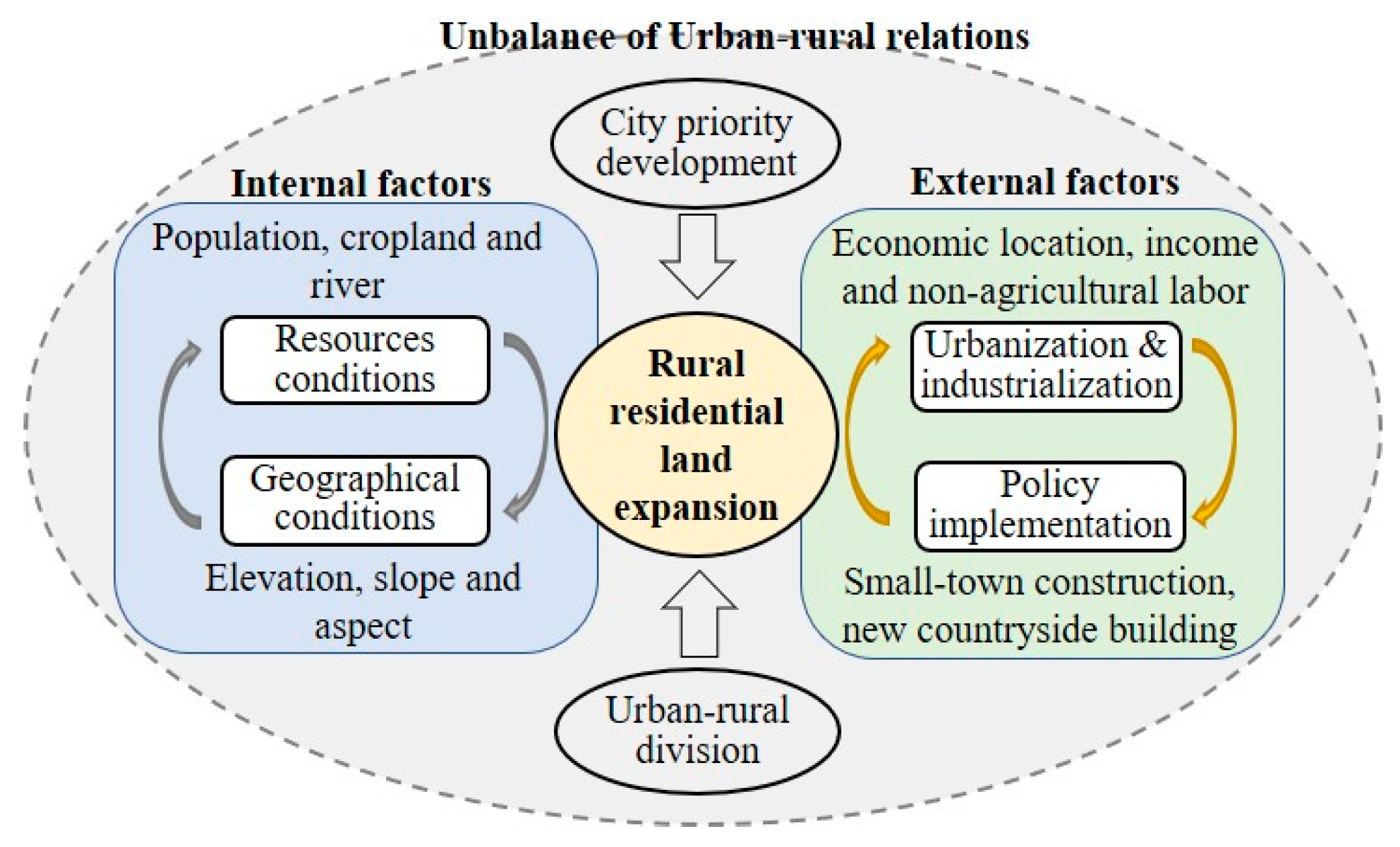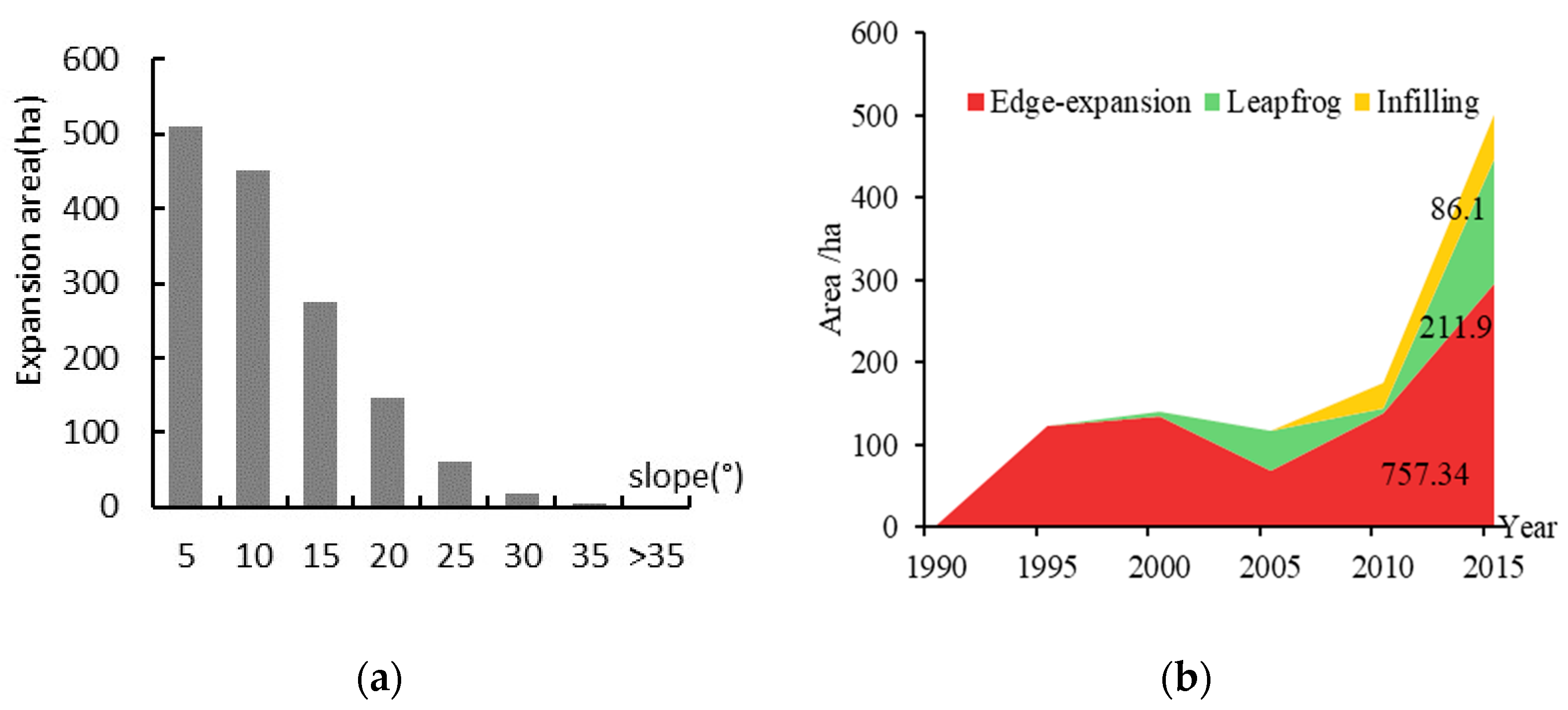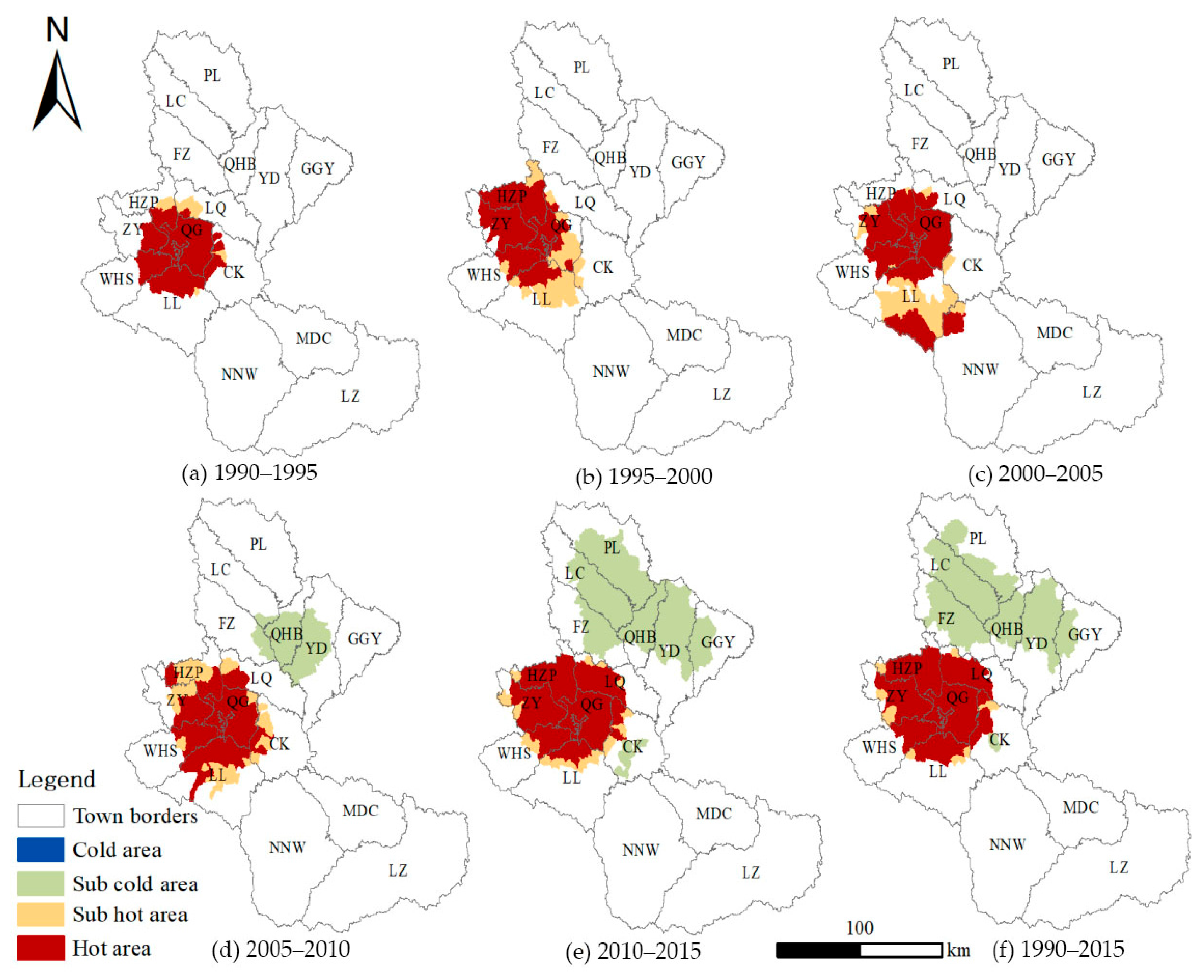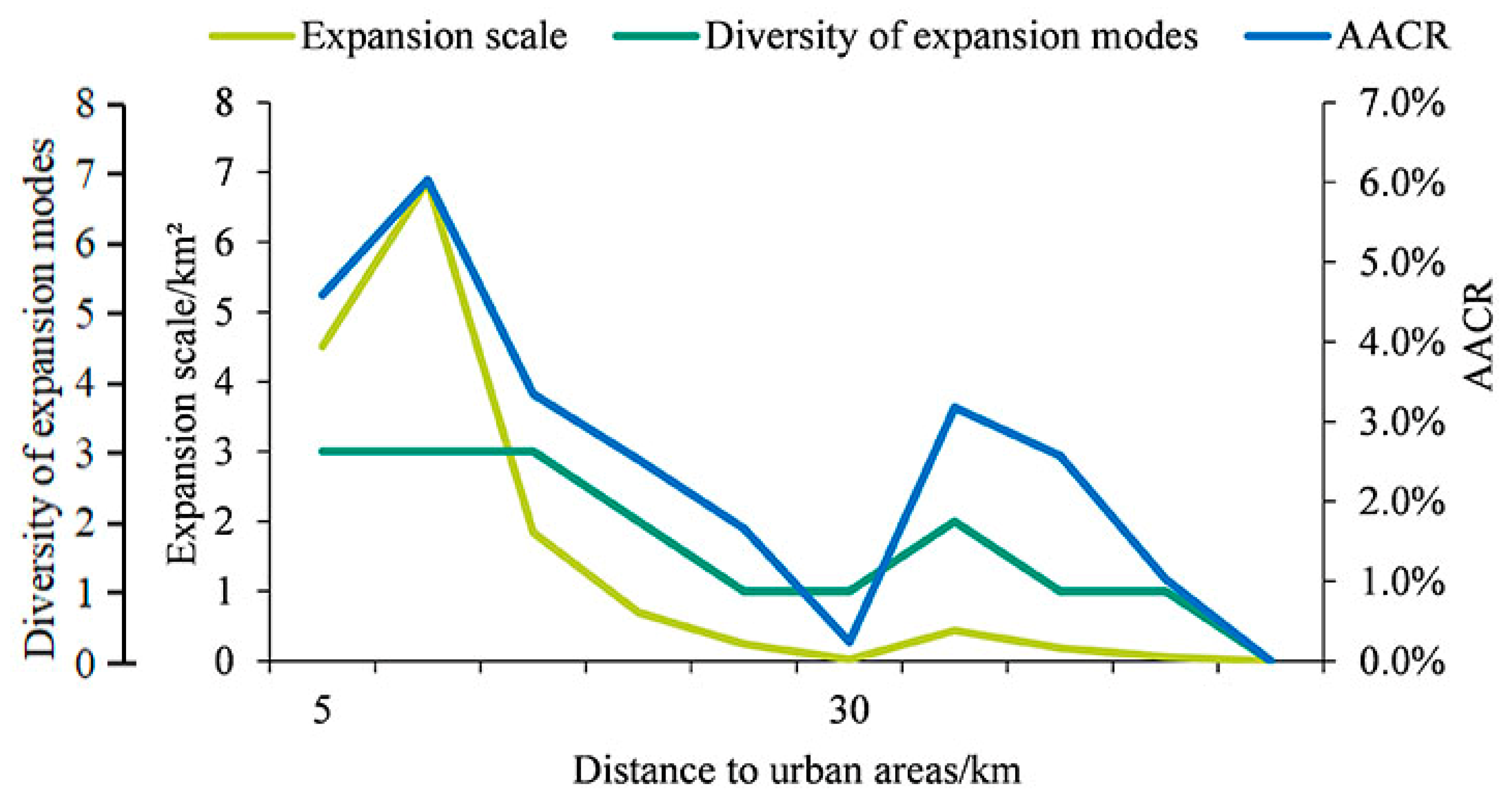The Expansion Mechanism of Rural Residential Land and Implications for Sustainable Regional Development: Evidence from the Baota District in China’s Loess Plateau
Abstract
1. Introduction
2. Research Background and Analytical Framework
2.1. The Context of the Chinese Rural Homestead System
2.2. An Explanatory Framework for Rural Residential Land Expansion
3. Materials and Methods
3.1. Study Area
3.2. Data Sources and Preprocessing
3.3. Methods
3.3.1. Rural Residential Land Expansion Modes
3.3.2. Getis-Ord Gi*
3.3.3. Potential Influencing Factors Selection
3.3.4. Binary Logistic Regression (BLR)
4. Results
4.1. Temporal Change of Rural Residential Land
4.2. Spatial Change of Rural Residential Land
4.2.1. Spatial Agglomeration Changes
4.2.2. Uneven Expansion of Rural Residential Land
4.3. Identifying the Driving Factors of Rural Residential Land Expansion
5. Discussion
5.1. Analysis of the Formation Mechanism of Rural Residential Land Expansion
5.2. Implications for Sustainable Regional Development
- New urban–rural integration. Speeding rural modernization cannot only depend on rural areas. Urban–rural integration is the only way to realize rural modernization [46]. Previous understandings surrounding the urban–rural relationship present a kind of antagonistic and unequal relationship. In fact, the urban–rural relationship is similar to a mother-child relationship, i.e., the countryside gave birth to a city, and the city is contained in the countryside. Urban and rural are closely related to each other in people, goods, capital, and other social transactions. Rural development needs to be supported by urban markets and services. However, the expected trickle-down effect remains dissatisfied [63], and industrial support was also absent in the practice of new countryside construction. Policymakers are encouraged to employ pertinent intervention to create a long-term mechanism for urban areas helping rural areas: for instance, (1) promoting urban–rural integration planning and realizing the complementary functions in urban and rural areas; (2) facilitating the integration of urban–rural infrastructure and public facilities, improving the production and living conditions of farmers; and (3) advancing the integration of urban–rural industries and employment, and realizing the balance of housing and work.
- Central town reconstruction. Central towns play significant prominent roles in the rural regional system, providing necessary public services for surrounding areas, and they are also the gathering centers of regional resource elements [43,64]. The results of this study also indicated that the “small-town construction” implementation had positive effects on rural residential land expansion. However, the construction progress of central towns in the Baota District is slow, and the central towns in the southern area of the Baota District have not yet been formed. On the one hand, due to the dualistic structure system of urban and rural areas, migrant workers entering the city cannot settle down, and their empty homesteads remain in the village [58], which hinders the relocation and integration of villages. On the other hand, the currently paid exit mechanism for rural homesteads needs to change, and the circulation of the rural land element of the market is not frictionless [65]. Moreover, the construction and management of central towns require talented people, but the loss and shortage of rural talents cannot support the construction of central towns [66]. Therefore, central town construction in the Baota District should first break the institutional bottleneck and achieve a reasonable flow of urban and rural elements. Secondly, policies should be introduced to attract talents back to villages so as to improve the capacity of endogenous development of villages. Finally, multi-center town structures should be set up, especially for central town construction in the south of the Baota District. In addition, in the process of multi-center town construction, decision-makers also need to ensure the employment supply in central towns [67].
- Ecological conservation area construction. Loess Plateau is one of the regions most seriously affected by soil erosion in the world [68,69]. The Chinese government implemented the “grain for green” projection to protect the local eco-environment. However, a large amount of grassland and woodland is still used for residential land construction. There were 161.65 ha of grassland and 66.71 ha of woodland transformed into residential land in the Baota District during 1990–2015. Therefore, it is necessary to construct ecological conservation areas. The results of this study indicated that the expansion of rural residential land was mainly concentrated around the city and in the river valley, and 84.3% of the newly added rural residential land was distributed below a slope of 15°. Previous studies have found that the soil erosion-sensitive areas on the Loess Plateau mainly occur in the zones with a slope of 8°–15° and 15°–25° [70]. Therefore, rural planners could plan rural life and ecological space according to the spatial difference characteristics of residential land expansion. Specifically, strict control measures such as residential land boundaries should be implemented in areas with a slope of 8° to 15°. The ecological protection region should concentrate on the regions with a slope above 15°.
6. Conclusions
Author Contributions
Funding
Institutional Review Board Statement
Informed Consent Statement
Data Availability Statement
Acknowledgments
Conflicts of Interest
References
- Yang, R.; Liu, Y.; Long, H.; Qiao, L. Spatio-temporal characteristics of rural settlements and land use in the Bohai Rim of China. J. Geogr. Sci. 2015, 25, 559–572. [Google Scholar] [CrossRef]
- Robinson, P.S. Implications of rural settlement patterns for development: A historical case study in Qaukeni, Eastern Cape, South Africa. Dev. S. Afr. 2003, 20, 405–421. [Google Scholar] [CrossRef]
- Palmisano, G.O.; Govindan, K.; Loisi, R.V.; Sasso, P.D.; Roma, R. Greenways for rural sustainable development: An integration between geographic information systems and group analytic hierarchy process. Land Use Policy 2016, 50, 250–429. [Google Scholar]
- Peucker, T.K. Johann Georg Kohl, a Theoretical Geographer of the 19th Century. Prof. Geogr. 2010, 20, 247–250. [Google Scholar] [CrossRef]
- Christaller, W. Die Zentralen Orte in Süddeutschland; Gustav Fischer: Jena, Germany, 1933. [Google Scholar]
- Semple, E. Influences of Geographic Environment: On the Basis of Ratzel’s System of Anthropo-Geography; Henry Holt: New York, NY, USA, 1911. [Google Scholar]
- Bański, J.; Wesołowska, M. Transformations in housing construction in rural areas of Poland’s Lublin region-Influence on the spatial settlement structure and landscape aesthetics. Landsc. Urban Plan. 2010, 94, 116–126. [Google Scholar] [CrossRef]
- Bella, K.P.; Irwin, E.G. Spatially explicit micro-level modelling of land use change at the rural-urban interface. Agric. Econ. 2002, 27, 217–232. [Google Scholar] [CrossRef]
- Yin, J.; Zhao, X.; Zhang, W.; Wang, P. Rural Land Use Change Driven by Informal Industrialization: Evidence from Fengzhuang Village in China. Land 2020, 9, 190. [Google Scholar] [CrossRef]
- Yang, R.; Xu, Q.; Long, H. Spatial distribution characteristics and optimized reconstruction analysis of China’s rural settlements during the process of rapid urbanization. J. Rural Stud. 2016, 47, 413–424. [Google Scholar] [CrossRef]
- Zhao, X.; Sun, H.; Chen, B.; Xia, X.; Li, P. China’s rural human settlements: Qualitative evaluation, quantitative analysis and policy implications. Ecol. Indic. 2019, 105, 398–405. [Google Scholar] [CrossRef]
- Zhou, Y.; Li, X.; Liu, Y. Land use change and driving factors in rural China during the period 1995–2015. Land Use Policy 2020, 99, 105048. [Google Scholar] [CrossRef]
- Lee, C.H. Understanding rural landscape for better resident-led management: Residents’ perceptions on rural landscape as everyday landscapes. Land Use Policy 2020, 94, 104565. [Google Scholar] [CrossRef]
- Sevenant, M.; Antrop, M. Settlement models, land use and visibility in rural landscapes: Two case studies in Greece. Landsc. Urban Plan. 2007, 80, 362–374. [Google Scholar] [CrossRef]
- McKenzie, P.; Cooper, A.; McCann, T.; Rogers, D. The ecological impact of rural building on habitats in an agricultural landscape. Landsc. Urban Plan. 2011, 101, 262–268. [Google Scholar] [CrossRef]
- Dahms, F.; Janine, M. ‘Counterurbanization’, Interaction and Functional Change in a Rural Amenity Area—A Canadian Example. J. Rural Stud. 1999, 15, 129–146. [Google Scholar] [CrossRef]
- Zhu, F.; Zhang, F.; Li, C.; Zhu, T. Functional transition of the rural settlement: Analysis of land-use differentiation in a transect of Beijing, China. Habitat Int. 2014, 41, 262–271. [Google Scholar] [CrossRef]
- Liu, Y.; Yang, R.; Li, Y. Potential of land consolidation of hollowed villages under different urbanization scenarios in China. J. Geogr. Sci. 2013, 23, 503–512. [Google Scholar] [CrossRef]
- Li, Y.; Li, Y.; Fan, P.; Long, H. Impacts of land consolidation on rural human-environment system in typical watershed of the Loess Plateau and implica-tions for rural development policy. Land Use Policy 2019, 86, 339–350. [Google Scholar]
- Gorbenkova, E.; Shcherbina, E. Historical-Genetic Features in Rural Settlement System: A Case Study from Mogilev District (Mogilev Oblast, Belarus). Land 2020, 9, 165. [Google Scholar] [CrossRef]
- Ancuța, C.A.; Olaru, M.; Popa, N.; Isfanescu-Ivan, R.; Jigoria-Oprea, L. Evaluation of the Sustainable Development of Rural Settlements. Case Study: Rural Settlements from Romanian Banat. Carpath J. Earth Environ. 2015, 3, 67–80. [Google Scholar]
- Cao, Y.; Bai, Z.; Sun, Q.; Zhou, W. Rural settlement changes in compound land use areas: Characteristics and reasons of changes in a mixed mining-rural-settlement area in Shanxi Province, China. Habitat Int. 2017, 61, 9–21. [Google Scholar] [CrossRef]
- Conrad, C.; Rudloff, M.; Abdullaev, I.; Thiel, M.; Löw, F.; Lamers, J.P.A. Measuring rural settlement expansion in Uzbekistan using remote sensing to support spatial planning. Appl. Geogr. 2015, 62, 29–43. [Google Scholar] [CrossRef]
- Cheng, M.; Liu, Y.; Zhou, Y. Measuring the symbiotic development of rural housing and industry: A case study of Fuping County in the Taihang Mountains in China. Land Use Policy 2019, 82, 307–316. [Google Scholar] [CrossRef]
- Li, H.; Song, W. Expansion of Rural Settlements on High-Quality Arable Land in Tongzhou District in Beijing, China. Sustainability 2019, 11, 5153. [Google Scholar] [CrossRef]
- Liu, Y.; Yang, Y.; Li, Y.; Li, J. Conversion from rural settlements and arable land under rapid urbanization in Beijing during 1985–2010. J. Rural. Stud. 2017, 51, 141–150. [Google Scholar] [CrossRef]
- Li, Y.; Li, Y.; Karácsonyi, D.; Liu, Z.; Wang, Y.; Wang, J. Spatio-temporal pattern and driving forces of construction land change in a poverty-stricken county of China and implications for poverty-alleviation-oriented land use policies. Land Use Policy 2020, 91, 104267. [Google Scholar] [CrossRef]
- Liu, Y.; Yang, R.; Long, H.; Gao, J.; Wang, J. Implications of land-use change in rural China: A case study of Yucheng, Shandong province. Land Use Policy 2014, 40, 111–118. [Google Scholar] [CrossRef]
- Li, H.; Song, W. Evolution of rural settlements in the Tongzhou District of Beijing under the new-type urbanization policies. Habitat Int. 2020, 101, 102198. [Google Scholar] [CrossRef]
- Wang, J.; Zhang, W.; Zhang, Z. Quantifying the Spatio-Temporal Dynamics of Rural Settlements and the Associated Impacts on Land Use in an Undevel-oped Area of China. Sustainability 2018, 10, 1490. [Google Scholar] [CrossRef]
- Ma, L.; Guo, X.; Tian, Y.; Wang, Y.; Chen, M. Micro-Study of the Evolution of Rural Settlement Patterns and Their Spatial Association with Water and Land Resources: A Case Study of Shandan County, China. Sustainability 2017, 9, 2277. [Google Scholar] [CrossRef]
- Liu, Y.; Li, Y. Revitalize the world’s countryside. Nature 2018, 548, 275–277. [Google Scholar] [CrossRef]
- Zou, L.; Liu, Y.; Wang, Y.; Hu, X. Assessment and analysis of agricultural non-point source pollution loads in China: 1978–2017. J. Environ. Manag. 2020, 263, 110400. [Google Scholar] [CrossRef] [PubMed]
- Ding, G.L. Study on the Evolvement of the Rural Homestead’ System since 1949. J. Hunan Agric. Univ. 2008, 4, 9–21. [Google Scholar]
- Wang, H.; Su, F.; Wang, L.; Tao, R. Rural Housing Consumption and Social Stratification in Transitional China: Evidence from a National Survey. Hous. Stud. 2012, 27, 667–684. [Google Scholar] [CrossRef]
- Rosato-Stevens, M. Peasant land tenure security in China’s transitional economy. Boston Univ. Int. Law J. 2008, 26, 97–141. [Google Scholar]
- Lin, G.C.S. Developing China: Land, Politics and Social Conditions; Routledge: New York, NY, USA, 2009. [Google Scholar]
- NBS Migrant Workers Monitoring Survey Report. Constr. Archit. 2018, 11, 31–35.
- Zhou, G.; He, Y.; Tang, C.; Tao, Y.; Zhong, T. Dynamic mechanism and present situation of rural settlement evolution in China. J. Geogr. Sci. 2013, 23, 513–524. [Google Scholar] [CrossRef]
- Luo, G.; Wang, B.; Luo, D.; Wei, C. Spatial Agglomeration Characteristics of Rural Settlements in Poor Mountainous Areas of Southwest China. Sustainability 2020, 12, 1818. [Google Scholar] [CrossRef]
- Chen, Z.; Liu, Y.; Feng, W.; Li, Y.; Li, L. Study on spatial tropism distribution of rural settlements in the Loess Hilly and Gully Region based on natural factors and traffic accessibility. J. Rural. Stud. 2019. [Google Scholar] [CrossRef]
- Shi, M.; Xie, Y.; Cao, Q. Spatiotemporal Changes in Rural Settlement Land and Rural Population in the Middle Basin of the Heihe River, China. Sustainability 2016, 8, 614. [Google Scholar] [CrossRef]
- Yang, R. An analysis of rural settlement patterns and their effect mechanisms based on road traffic accessibility of Guangdong. J. Geogr. Sci. 2017, 72, 1859–1871. [Google Scholar]
- Li, Y.; Liu, Y.; Long, H. Spatio-temporal Analysis of Population and Residential Land Change in Rural China. J. Nat. Resour. 2010, 25, 1629–1638. [Google Scholar]
- Li, D.; Wang, D.; Li, H.; Zhang, S.; Zhang, X.; Ye, T. The Effects of Urban Sprawl on the Spatial Evolution of Rural Settlements: A Case Study in Changchun, China. Sustainability 2016, 8, 736. [Google Scholar] [CrossRef]
- Liu, Y. Introduction to land use and rural sustainability in China. Land Use Policy 2018, 74, 1–4. [Google Scholar] [CrossRef]
- Ma, W.; Jiang, G.; Zhang, R.; Li, Y.; Jiang, X. Achieving rural spatial restructuring in China: A suitable framework to understand how structural transitions in rural residential land differ across peri-urban interface? Land Use Policy 2018, 75, 583–593. [Google Scholar] [CrossRef]
- Liu, J.; Ning, J.; Kuang, W.; Xu, X.; Zhang, S.; Yan, C.; Li, R.; Wu, S.; Hu, Y.; Du, G.; et al. Spatio-temporal patterns and characteristics of land-use change in China during 2010–2015. J. Geogr. Sci. 2018, 73, 789–802. [Google Scholar]
- Xu, M.; He, C.; Liu, Z.; Dou, Y. How Did Urban Land Expand in China between 1992 and 2015? A Multi-Scale Landscape Analysis. PLoS ONE 2016, 11, e154839. [Google Scholar] [CrossRef] [PubMed]
- Ma, X.; Zhu, C.; Ma, R.; Pu, Y. Urban spatial pattern and its evolution in Suzhou, Jiangsu province, China. Acta Geogr. Sin. 2008, 63, 405–416. [Google Scholar]
- Ariti, A.; Van Vliet, J.; Verburg, P.H. Land-use and land-cover changes in the Central Rift Valley of Ethiopia: Assessment of perception and adaptation of stake-holders. Appl. Geogr. 2015, 65, 541–542. [Google Scholar] [CrossRef]
- Tan, M.; Li, X. The changing settlements in rural areas under urban pressure in China: Patterns, driving forces and policy implications. Landsc. Urban Plan. 2013, 120, 170–177. [Google Scholar] [CrossRef]
- Lever, J.; Krzywinski, M.; Altman, N. Points of significance: Logistic regression. Nat. Methods 2016, 13, 541–542. [Google Scholar] [CrossRef]
- Zhou, X.; Liu, Y. Peasants’ Income Structure Evolution and Its Enlightenment. Chin. Agric. Sci. Bull. 2012, 28, 210–213. [Google Scholar]
- Kim, J.H.; Pagliara, F.; Preston, J. The Intention to Move and Residential Location Choice Behaviour. Urban Stud. 2005, 42, 1621–1636. [Google Scholar] [CrossRef]
- Ilaria, Z.; Artemi, C.; Filippo, G.; Gianluca, E.; Luca, S. Industrial Sprawl and Residential Housing: Exploring the Interplay between Local Development and Land-Use Change in the Valencian Community, Spain. Land 2019, 8, 143. [Google Scholar]
- Zambon, I.; Serra, P.; Sauri, D.; Carlucci, M.; Salvati, L. Beyond the ‘Mediterranean city’: Socioeconomic disparities and urban sprawl in three Southern European cities. Geogr. Ann. Ser. B Hum. Geogr. 2017, 99, 319–337. [Google Scholar] [CrossRef]
- Su, S.; Zhang, Q.; Zhang, Z.; Zhi, J.; Wu, J. Rural settlement expansion and paddy soil loss across an ex-urbanizing watershed in eastern coastal China during market transition. Reg. Environ. Chang. 2011, 11, 651–662. [Google Scholar] [CrossRef]
- Feng, J.; Tang, S.; Yang, Z. Determinants of entrepreneurial behavior of rural migrants in urban society: From the perspective of ‘human-environment relationship’. Geogr. Res. 2016, 35, 148–162. [Google Scholar]
- Guo, X.; Niu, S.; Wu, W.; Ma, L. Characters of rural settlement spatial distribution and its influencing factors in Loess hilly area of Gansu Province: A case of Qinan County, Gansu Province. J. Arid Land Resour. Environ. 2010, 24, 27–32. [Google Scholar]
- Li, M.; Zhang, G.; Lan, H.; Zhou, J. A study on the Change of Chinese New Countryside Construction at the Provincial Level: Based on a Comparative Analysis of the Tracking Survey Data of “100 Villages and 1000 Households” in 2006 and 2015 in Liaoning Province. Issues Agric. Econ. 2017, 38, 36–45. [Google Scholar]
- Gao, J.; Jiang, W.; Chen, J.; Liu, Y. Housing-industry symbiosis in rural China: A multi-scalar analysis through the lens of land use. Appl. Geogr. 2020, 124, 102281. [Google Scholar] [CrossRef]
- Tacoli, C. Rural-urban interactions: A guide to the literature. Environ. Urban 1998, 10, 147–166. [Google Scholar] [CrossRef]
- Baker, J. Small town Africa: Studies in rural-urban interaction. Int. J. Afr. Hist. Stud. 1990, 1, 284–290. [Google Scholar]
- Tu, S.; Long, H.; Zhang, Y.; Ge, D.; Qu, Y. Rural restructuring at village level under rapid urbanization in metropolitan suburbs of China and its implications for in-novations in land use policy. Habitat Int. 2018, 77, 143–152. [Google Scholar] [CrossRef]
- Li, Y.; Fan, P.; Liu, Y. What makes better village development in traditional agricultural areas of China? Evidence from long-term observation of typical villages. Habitat Int. 2019, 83, 111–124. [Google Scholar] [CrossRef]
- Yang, T.; Jin, Y.; Yan, L.; Pei, P. Aspirations and realities of polycentric development: Insights from multi-source data into the emerging urban form of Shanghai. Environ. Plan. B Plan. Des. 2019, 7, 1264–1280. [Google Scholar] [CrossRef]
- Yuan, X.; Han, J.; Shao, Y.; Li, Y.; Wang, Y. Geodetection analysis of the driving forces and mechanisms of erosion in the hilly-gully region of northern Shaanxi Province. J. Geogr. Sci. 2019, 29, 779–790. [Google Scholar] [CrossRef]
- Li, Y.; Zhang, X.; Cao, Z.; Liu, Z.; Lu, Z.; Liu, Y. Towards the progress of ecological restoration and economic development in China’s Loess Plateau and strategy for more sustainable development. Sci. Total Environ. 2021, 756, 143676. [Google Scholar]
- Fu, B.J.; Liu, Y.; Lu, Y.H.; He, C.S.; Zeng, Y.; Wu, B.F. Assessing the soil erosion control service of ecosystems change in the Loess Plateau of China. Ecol. Complex 2011, 8, 284–293. [Google Scholar] [CrossRef]





| Category | Potential Variables | Abbr. | Explanation |
|---|---|---|---|
| Basic geographical conditions | Elevation | x1 | |
| Slope | x2 | ||
| Aspect | x3 | ||
| Distance to cropland | x4 | ||
| Distance to rivers | x5 | ||
| Resources conditions | Total area of cropland | x6 | |
| Per capita cropland | x7 | Total cropland/rural resident population | |
| Total population | x8 | ||
| Population density | x9 | Rural resident population/total area of rural | |
| Urbanization & industrialization | Distance to state road | x10 | |
| Distance to provincial road | x11 | ||
| Distance to urban area | x12 | ||
| Proportion of non-agricultural labors | x13 | Number of labors in industry or tertiary/total number of labors | |
| Per capita income | x14 | ||
| Policy implementation | Small-town construction | x15 | Is there a “Small-town construction” project in village? Yes = 1, No = 2 |
| New countryside building | x16 | Is there a “New countryside building” project in village? Yes = 1, No = 2 |
| Land Type | Total Rural Residential Land Expansion | Edge Expansion | Leapfrog | Infilling | ||||
|---|---|---|---|---|---|---|---|---|
| Area (ha) | Percentage * (%) | Area (ha) | Percentage ** (%) | Area (ha) | Percentage ** (%) | Area (ha) | Percentage ** (%) | |
| Cropland | 796.93 | 75.52 | 556.16 | 73.44 | 163.01 | 76.92 | 77.76 | 90.36 |
| Woodland | 66.71 | 6.32 | 63.22 | 8.35 | 2.10 | 0.99 | 1.39 | 1.62 |
| Grassland | 161.65 | 15.32 | 120.18 | 15.87 | 35.44 | 16.72 | 6.04 | 7.02 |
| River | 22.73 | 2.15 | 12.44 | 1.64 | 9.42 | 4.45 | 0.86 | 1.00 |
| Pond | 5.12 | 0.49 | 5.12 | 0.68 | 0.00 | 0.00 | 0.00 | 0.00 |
| Grassy marsh | 2.16 | 0.20 | 0.21 | 0.03 | 1.95 | 0.92 | 0.00 | 0.00 |
| Category | Potential Variables | Coefficients |
|---|---|---|
| Basic geographical conditions | Elevation | −1.145 ** |
| Slope | −0.323 ** | |
| Aspect | −0.045 | |
| Distance to cropland | 0.241 * | |
| Distance to rivers | 0.169 | |
| Resources conditions | Total area of cropland | −0.764 ** |
| Per capita cropland | −0.105 | |
| Total population | 2.013 ** | |
| Population density | 5.855 ** | |
| Urbanization & industrialization | Distance to state road | −1.38 ** |
| Distance to provincial road | −0.607 ** | |
| Distance to urban area | −3.129 ** | |
| Proportion of non-agricultural labors | 0.964 ** | |
| Per capita income | 1.097 ** | |
| Policy implementation | Small-town construction | 2.158 * |
| New countryside building | 0.16 | |
| Constant | −0.54 ** | |
| Adjusted R-square | 0.79 | |
Publisher’s Note: MDPI stays neutral with regard to jurisdictional claims in published maps and institutional affiliations. |
© 2021 by the authors. Licensee MDPI, Basel, Switzerland. This article is an open access article distributed under the terms and conditions of the Creative Commons Attribution (CC BY) license (http://creativecommons.org/licenses/by/4.0/).
Share and Cite
Chen, Z.; Liu, X.; Lu, Z.; Li, Y. The Expansion Mechanism of Rural Residential Land and Implications for Sustainable Regional Development: Evidence from the Baota District in China’s Loess Plateau. Land 2021, 10, 172. https://doi.org/10.3390/land10020172
Chen Z, Liu X, Lu Z, Li Y. The Expansion Mechanism of Rural Residential Land and Implications for Sustainable Regional Development: Evidence from the Baota District in China’s Loess Plateau. Land. 2021; 10(2):172. https://doi.org/10.3390/land10020172
Chicago/Turabian StyleChen, Zongfeng, Xueqi Liu, Zhi Lu, and Yurui Li. 2021. "The Expansion Mechanism of Rural Residential Land and Implications for Sustainable Regional Development: Evidence from the Baota District in China’s Loess Plateau" Land 10, no. 2: 172. https://doi.org/10.3390/land10020172
APA StyleChen, Z., Liu, X., Lu, Z., & Li, Y. (2021). The Expansion Mechanism of Rural Residential Land and Implications for Sustainable Regional Development: Evidence from the Baota District in China’s Loess Plateau. Land, 10(2), 172. https://doi.org/10.3390/land10020172









